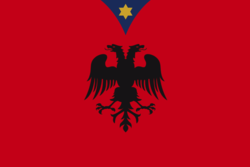
Back الإسلام في ألبانيا Arabic Albaniyada islam Azerbaijani Албанияла ислам Bashkir আলবেনিয়ায় ইসলাম Bengali/Bangla Islam in Albanien German اسلام در آلبانی Persian Islam en Albanie French Az iszlám Albániában Hungarian Islam di Albania ID アルバニアのイスラム教 Japanese
| Islam by country |
|---|
 |
|
|

| Islam by country |
|---|
 |
|
|
| Part of a series on |
| Albanians |
|---|
 |
| By country |
|
| Culture |
| Religion |
| Languages and dialects |
Islam arrived in Albania mainly during the Ottoman period when the majority of Albanians over time converted to Islam under Ottoman rule, but Islam was introduced to Albanians back in the 8th century during trades. Following the Albanian National Awakening (Rilindja) tenets and the de-emphasis of religious tradition in Albania, all governments in the 20th century pursued a secularization policy, most aggressively under the People's Socialist Republic of Albania. Due to this policy, Islam, as with all other faiths in the country, underwent radical changes. Decades of state atheism, which ended in 1991, brought a decline in the religious practice of all traditions. The post-communist period and the lifting of legal and other government restrictions on religion allowed Islam to revive through institutions that generated new infrastructure, literature, educational facilities, international transnational links and other social activities.[2]
According to the 2023 census, there were 1,101,718 (45.86%) Sunni Muslims and 115,644 (4.81%) Bektashi Muslims. The remaining population consists of 201,530 (8.38%) Catholics, 173,645 (7.22%) Eastern Orthodox, 9,658 (0.4%) Evangelicals, 3 670 (0.15%) of other religions, 332,155 (13.82%) believers without denomination, 85,311 (3.55%) Atheists and 378,782 (15.76%) did not provide an answer.[3]
- ^ "Religious Composition by Country, 2010-2050". Pew Research Center. 12 April 2015. Retrieved 22 October 2017.
- ^ Cite error: The named reference
Elbasani347353was invoked but never defined (see the help page). - ^ "Population and Housing Census 2023" (PDF). Instituti i Statistikës (INSTAT).
© MMXXIII Rich X Search. We shall prevail. All rights reserved. Rich X Search
